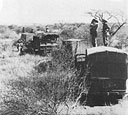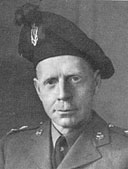
9
1st S.A. Division enters Abyssinia
The 5th S.A. Infantry Brigade Group, while the El Yibo-El Sardu moves were being made on 2nd S.A. Infantry Brigade front, was busy with very active patrolling on the Marsabit-Moyale road to drive out any enemy troops remaining on the Kenya side of the frontier, whilst at the same time creating the maximum impression that an advance was being planned against Moyale itself from Marsabit. As part of this general policy of aggressive subterfuge, instructions were issued on 12 January for 5th S.A. Infantry Brigade Group to send out a strong fighting patrol to the Turbi Hills to locate and test waterholes, with a view to basing a strong detachment in the area. Travelling over an atrocious road, and taking a whole day to cover only 80 miles, the patrol found only one waterhole with a meagre yield of 50 gallons a day.
Subsequent reports indicated to Force Headquarters that the enemy was withdrawing from the Moyale-Mega area, and 1st S.A. Infantry Brigade--still under command of 12th African Division--was instructed to patrol towards both British and Italian Moyale from the Wajir-Arbo area. On 22 January Brigadier Armstrong was instructed to send a strong 5th S.A. Infantry Brigade patrol towards Sololo and Moyale, from the west. It consisted of 'B' Company, 3rd Transvaal Scottish, with one section of Vickers guns, one section of mortars, an anti-tank rifle section, a detachment of Engineers from 5th Field Company under Sergeant G. W. Tytherleigh and a wireless van in Force 'A' under Major G. E. Sturgeon of the Transvaal Scottish, and 'C Company of 2nd Regiment Botha under Captain E. Delaney, with similar supporting and ancillary sections plus No. 3 Platoon of No. 1 S.A. Armoured Car Company under Lieutenant Roy Irwin, all in Force 'B'. A light section of 11th Field Ambulance, S.A.M.C. accompanied the patrol. Force 'B' was to patrol actively to Sololo first and then towards Moyale, backed by Force 'A'.
On 24 January the combined force arrived at the Turbi Hills, where they prepared a defensive position. Lieutenant Irwin, with Lieutenant W. H. Penny, was instructed to escort the Regiment Botha company the 20 miles or so north-eastward towards Sololo with only four armoured cars next morning, the other cars of the platoon being kept as mobile protection for the Transvaal Scottish at Turbi--an extraordinary display of lack of confidence on the part of infantry with their



